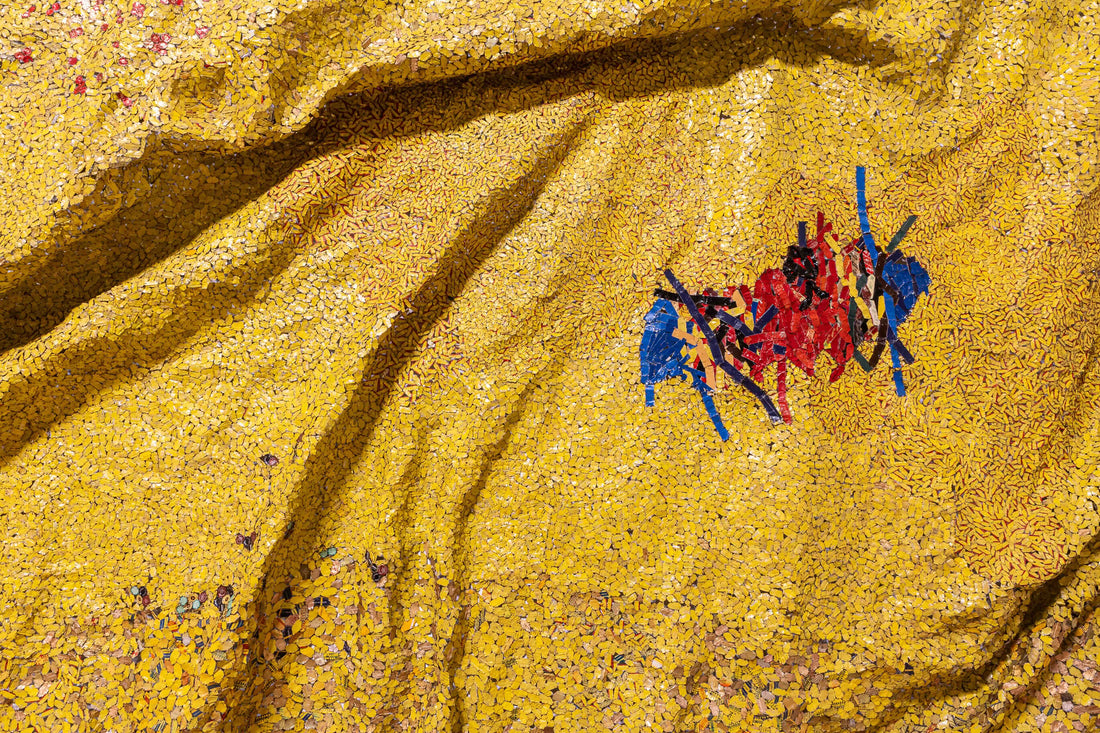
Top of the World: The work of El Anatsui
A seductive golden rainfall cascades in dripping folds across the whole wall in the Talbot Rice Gallery in Edinburgh. Scottish Mission Book Depot is hung so that squiggly swathes of metal at the base of the work look like a woman’s face by Cocteau. In places, there are flashes of blue, red, and silver. The material is sensuous and voluptuous, it’s only as the viewer gets closer that the textile reveals itself to be made of flattened bottle tops and squashed cutouts of aluminium bottle labels. The piece is a specially commissioned work by the 80-year-old Ghanaian artist El Anatsui for this, the largest show of his work in the UK.
 Image and image above: El Anatsui, ‘Scottish Mission Book Depot Keta’,2024. Installation views. Courtesy of Talbot Rice Gallery, University of Edinburgh. Photo: Sally Jubb.
Image and image above: El Anatsui, ‘Scottish Mission Book Depot Keta’,2024. Installation views. Courtesy of Talbot Rice Gallery, University of Edinburgh. Photo: Sally Jubb.
Born in Ghana in 1944 during British colonial rule, El Anatsui was brought up by his mother’s brother, a Presbyterian reverend, after his mother’s early death. Although never religious, El Anatsui used to receive books and art materials from the Scottish Missionaries Book Depot. “The composition of the new work, with its expansive field of yellow and squiggly lines of colour on the lower right, speaks to my childhood experience of using crayons provided by the Scottish Mission, as my earliest medium of self-expression,” he says. “I cannot but regard this first exhibition of mine in Edinburgh as having come full circle after several decades.”
 Image: El Anatsui, ‘Scottish Mission Book Depot Keta’,2024. Installation views. Courtesy of Talbot Rice Gallery, University of Edinburgh. Photo: Sally Jubb.
Image: El Anatsui, ‘Scottish Mission Book Depot Keta’,2024. Installation views. Courtesy of Talbot Rice Gallery, University of Edinburgh. Photo: Sally Jubb.
His childhood experiences were amplified in adolescence, as he began to understand the effects of colonialism not only in post-independence Ghana but also across Africa. His works examine colonisation, the effects of land grab, and the trade in alcohol and cloth in exchange for gold and enslaved people. He looks at political, postcolonial, and social histories in artworks made of tens of thousands of aluminium bottle tops, reclaimed from Ghanaian and Nigerian liquor bottling (and increasingly printing-press) industries stitched together. His first major work using this process, Woman’s Cloth (2001), is in the show. In the 15th-century, “trade spirits” – gin, whisky, and brandy – were introduced into West Africa, and by the 16th century, alcohol was the second most important import after textiles.
Want to read more of this article?
We are proud to be a subscriber-funded publication with members in 185 countries. We know our readership is passionate about textiles, so we invite you to help us preserve and promote the stories, memories, and histories that fabric holds. Your support allows us to publish our magazine, and also ‘what's on’ information, and subscription interviews, reviews, and long-read articles in our online blog.
ALREADY A SUBSCRIBER? CLICK HERE TO ACCESS CONTENT
OR...to continue reading….

*Magazine subscribers automatically get free access to all our online content. We send the access code by email with the publication of each issue. You will also find it on the envelope containing your magazine. Please note the access code changes every issue.*

Born in Ghana in 1944 during British colonial rule, El Anatsui was brought up by his mother’s brother, a Presbyterian reverend, after his mother’s early death. Although never religious, El Anatsui used to receive books and art materials from the Scottish Missionaries Book Depot. “The composition of the new work, with its expansive field of yellow and squiggly lines of colour on the lower right, speaks to my childhood experience of using crayons provided by the Scottish Mission, as my earliest medium of self-expression,” he says. “I cannot but regard this first exhibition of mine in Edinburgh as having come full circle after several decades.”

His childhood experiences were amplified in adolescence, as he began to understand the effects of colonialism not only in post-independence Ghana but also across Africa. His works examine colonisation, the effects of land grab, and the trade in alcohol and cloth in exchange for gold and enslaved people. He looks at political, postcolonial, and social histories in artworks made of tens of thousands of aluminium bottle tops, reclaimed from Ghanaian and Nigerian liquor bottling (and increasingly printing-press) industries stitched together. His first major work using this process, Woman’s Cloth (2001), is in the show. In the 15th-century, “trade spirits” – gin, whisky, and brandy – were introduced into West Africa, and by the 16th century, alcohol was the second most important import after textiles.
Want to read more of this article?
We are proud to be a subscriber-funded publication with members in 185 countries. We know our readership is passionate about textiles, so we invite you to help us preserve and promote the stories, memories, and histories that fabric holds. Your support allows us to publish our magazine, and also ‘what's on’ information, and subscription interviews, reviews, and long-read articles in our online blog.
ALREADY A SUBSCRIBER? CLICK HERE TO ACCESS CONTENT
OR...to continue reading….

*Magazine subscribers automatically get free access to all our online content. We send the access code by email with the publication of each issue. You will also find it on the envelope containing your magazine. Please note the access code changes every issue.*
